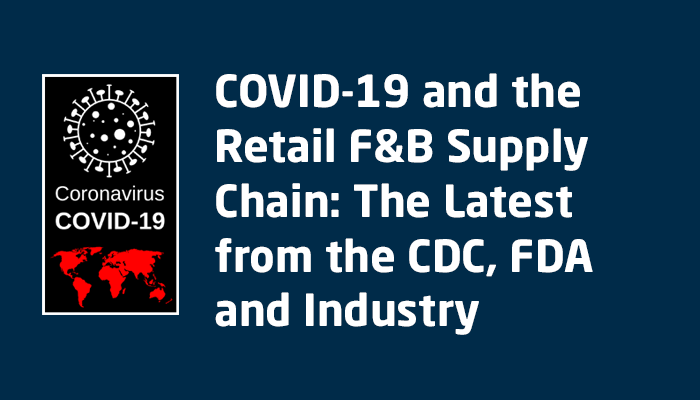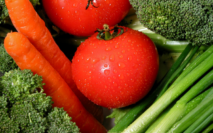March 31, 2020: Chances are your life isn’t the same as it was just two or three weeks ago. In the time of COVID-19, you might be self-quarantining. Your local government may have closed your neighborhood playgrounds and parks. Or maybe your governor has issued a stay-at-home order.
There’s also a very good chance that many of your favorite restaurants and bars are closed. In fact, all the “non-essential” or “non-life-sustaining” businesses in your community might be shut down.
One thing hasn’t changed, however: You can still go to the grocery store. You may have to wait in a line, standing on lengths of tape or spray-painted lines spaced at the proper social distance (six feet). Your store may limit how many people are allowed inside at one time. It may have set up special hours for senior citizens to shop.
But your grocery store is still open. This means the food and beverage supply chain continues to operate during the COVID-19 pandemic. Let’s take a look at a few things you should be aware of today.
1. The Basics: What is the CDC saying about grocery stores and COVID-19?
The Centers for Disease Control and Prevention (CDC) doesn’t have specific guidance for grocery stores; instead, it provides “Interim Guidance for Businesses and Employers to Plan and Respond to Coronavirus Disease 2019 (COVID-19).” It clearly states that businesses and employers can prevent and slow the spread of COVID-19.
The CDC’s key recommendations are summarized below. See the full details here, and visit the CDC website regularly to get the latest news about COVID-19 and recommendations for staying safe.
Reduce transmission among employees
- Actively encourage sick employees to stay home.
- Identify where and how workers might be exposed to COVID-19 at work.
- Separate sick employees.
- Educate employees about how they can reduce the spread of COVID-19.
Maintain healthy business operations
- Identify a workplace coordinator who will be responsible for COVID-19 issues and their impact at the workplace.
- Implement flexible sick leave and supportive policies and practices.
- Assess your essential functions and the reliance that others and the community have on your services or products.
- Determine how you will operate if absenteeism spikes (e.g., from employees getting sick or having to stay home to care for family members or to watch children).
- Establish policies and practices for social distancing.
- If you have more than one business location, give local managers the authority to take appropriate actions outlined in their COVID-19 response plan based on local conditions.
Maintain a healthy work environment
- Consider improving the engineering controls using the building ventilation system (e.g., increase ventilation rates and the percentage of outdoor air that circulates into the system).
- Support respiratory etiquette and hand hygiene for employees, customers, and worksite visitors.
- Perform routine environmental cleaning.
- Perform enhanced cleaning and disinfection after people suspected/confirmed to have COVID-19 have been in your place of business.
2. What are industry associations saying about COVID-19?
Grocery workers are being hailed as heroes and front-line fighters; they are the penultimate link the retail food supply chain, the people who literally hand products to consumers. Here is what some industry associations in the United States are saying about COVID-19.
The National Grocer’s Association provides best practices for its members. These follow the CDC guidance, but also have grocery-specific recommendations, such as:
- Assigning employees to regularly sanitize shopping carts and other high-traffic or high-touch areas
- Increasing or adding hand sanitizing stations around stores for customers and employees
- Changing store hours to encourage shopping at times with fewer people
- Scheduling specific hours of operation for vulnerable populations to shop without other customers
The Food Industry Association provides extensive resources about COVID-19. Visit its “Key Resources” page here. It also offers two excellent publications for download: Guidance for the Food Industry: Coronavirus Outbreak: I. Best Practices and Planning for the Immediate Situation (March 17, 2020) and Guidance for the Food Industry: Coronavirus Outbreak II. Short-Term Best Practices (March 26, 2020). Both offer guidance and information about the food supply chain, including:
- Evaluate receiving and delivery practices to minimize human-to-human contact. For example, limit the sharing of pens or equipment.
- Work with suppliers to identify local manufacturers and producers of essential products.
- Coordinate with buying departments or retail customers; learn about their plans to “bulk up” on core items so facilities can be secured for emergency storage.
- Increase volumes in-demand items such as pasta, sauces, canned foods, instant noodles, frozen meals/foods, cleaning detergents, alcohol, hand sanitizer, and paper products.
- Offer to collect from suppliers where stock is available; agree on basic commercial terms to cover costs.
- Accept deliveries when they’re available from suppliers and prioritize inbound bookings.
- Relax on-time performance metrics.
The American Beverage Association is one of 60 signatories to a letter advocating for a national public framework in which food, beverage, and consumer packaged goods manufacturers and their transporters are exempt from bans and curfews. It called for “uniformity and consistent policies,” noting that food, beverage, and other packaged goods manufacturing facilities have been exempted from bans and curfews in some states but not others. These groups say a uniform national policy will “ensure continuous delivery of essential services.”
Furthermore, on March 18, the association sent a letter directly to President Trump “advocating for common-sense actions to help our industry operate and deliver products during this challenging time.” These include (quoted verbatim):
- Exempting employees involved in the manufacture, distribution, delivery, and stocking of food and beverage items from federal, state, or local restrictions to ensure continuous delivery of essential services.
- Putting forth an executive action to lift truck weight limits, historically governed by state law, to facilitate meeting the critical need of delivering essential goods in response to COVID-19.
- Clarifying ambiguity surrounding the Federal Motor Carrier Safety Administration’s (FMCSA) hours of service guidance. Specifically, requesting the FMCSA clarify in writing that the restocking of grocery store shelves by delivery drivers is included in what constitutes direct assistance for supporting emergency relief efforts.
3. What is the U.S. Food and Drug Administration (FDA) saying about COVID-19 and the food supply chain?
The FDA released its latest statement concerning the food supply chain on March 28. In it, the agency said it was “working around the clock to make sure that Americans have access to safe food and medical products.” Here are the key statements concerning the food supply:
- Retail supply chains remain strong.
- The FDA is working with food manufacturers and grocery stores to identify shortages in the human and animal food supply chain. It is in contact with industry and trade associations about supply chain issues.
- There are “no widespread disruptions reported in the [human and animal food] supply chain.”
- “Empty grocery shelves” resulted from “unprecedented demand,” not shortcomings in the ability to produce, process, and deliver goods.
On March 26, the FDA released “Temporary Policy Regarding Preventive Controls and FSVP Food Supplier Verification Onsite Audit Requirements During the COVID-19 Public Health Emergency: Guidance for Industry” (Docket No. FDA-2020-D-1108). It states the FDA’s “current intent … in certain circumstances related to the impact of the coronavirus outbreak (COVID-19).” It contains nonbinding recommendations, not a legal pronouncements; companies “can use an alternative approach if it satisfies the requirements of the applicable statutes and regulations.”
The document address regulations in three areas
- Current Good Manufacturing Practice, Hazard Analysis, and Risk-Based Preventive Controls for Human Food
- Current Good Manufacturing Practice, Hazard Analysis, and Risk-Based Preventive Controls for Food for Animals
- Foreign Supplier Verification Programs for Importers of Food for Humans and Animals
Final Thoughts
The situation is changing every hour, every day. Like all responsible companies, rfxcel is monitoring the spread and affects of COVID-19. Foremost in our minds is the well-being of our employees and their families and our customers and their employees and families.
As for the F&B supply chain, we have powerful solutions to help keep things moving. The latest version of our signature rfxcel Traceability System (rTS) is the most complete and flexible raw materials and finished goods traceability solution for F&B. And our rfxcel MobileTraceability app can track any batch, movement, and handler at any location, putting the power of a digital supply chain at your fingertips. Learn more about these and our other solutions for F&B here.
And we want our customers to know we are open and operating at full capacity. Our supply chain solutions are designed to keep working under extraordinary circumstances. If you have any questions or concerns, contact your rfxcel account and project managers.
Please keep an eye out for further updates via email and on our website, and contact us if you have any questions, We are here to help and answer your questions.





